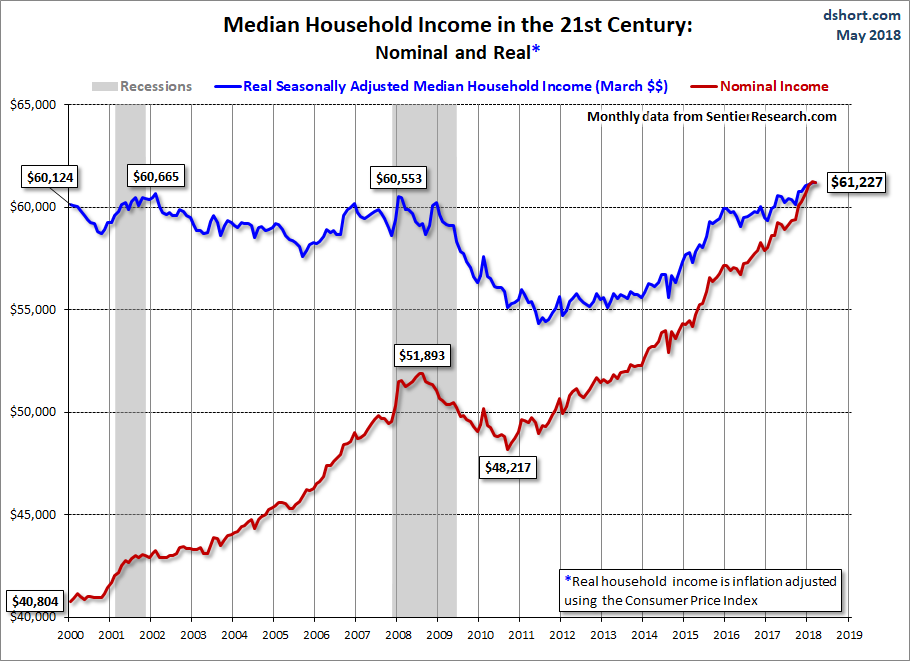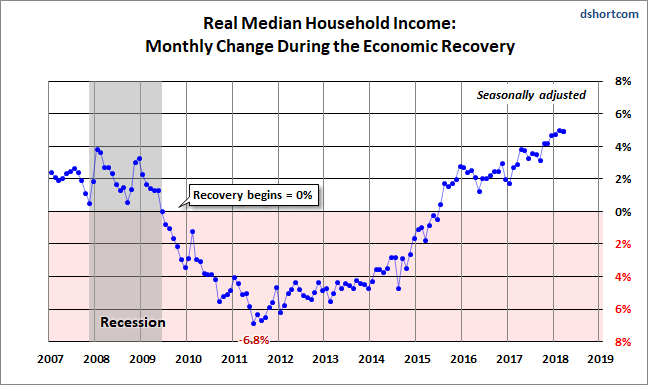Real Median Household Income Unchanged In July
The Sentier Research median household income data for July, released this morning, came in at $57,190. The nominal median was essentially unchanged (-$16 month-over-month) but is up $1,431 year-over-year. In percentages, the July number is flat MoM but up 2.6% YoY. Adjusted for inflation, the latest income was also unchanged MoM but is up $940 YoY. The real numbers equate to changes of 0.0% MoM and 1.7% YoY.
In real dollar terms, the median annual income is 1.8% lower (-$1,024) than its interim high in January 2008 but well off its low in August 2011.
Background on Sentier Research
The traditional source of household income data is the Census Bureau, which publishes annual household income data in mid-September for the previous year.
Sentier Research, an organization that focuses on income and demographics, offers a more up-to-date glimpse of household incomes by accessing the Census Bureau data and publishing monthly updates. Sentier Research has now released its most recent update, data through November (available here). The numbers in their report differ from the Census Bureau's in three key respects:
- It is a monthly rather than annual series, which gives a more granular view of trends.
- Their numbers are more current. The Census Bureau's most recent is the 2014 annual data released in September 2015.
- Sentier Research uses the more familiar Consumer Price Index (CPI) for the inflation adjustment. The Census Bureau uses the little-known CPI-U-RS (RS stands for "research series") as the deflator for their annual data. For more on that topic, see this commentary.
Monthly Median Household Income Since 2000
The first chart below is an overlay of the nominal values and real monthly values chained in the dollar value as of the latest month. The red line illustrates the history of nominal median household, and the blue line shows the real (inflation-adjusted value). Callouts show specific nominal and real monthly values for the January 2000 start date and the peak and post-peak troughs.

In the latest press release, Sentier Research spokesman Gordon Green summarizes the recent data:
“Even though the July 2016 median annual household income was not statistically dif ferent than June, it marks another month of flattening since two previous monthly declines in the median of 0.9 and 0.4 percent, respectively. We continue to monitor the course of inflation, as this has a significant effect on the trend in real median annu al household income. We are now at a point now where median household income is about at the same level as the beginning of the great recession in December 2007, and 1.1 percent lower than January 2000, the beginning of this statistical series.”
As for the data itself, Sentier makes it available in Excel format for a small fee (here). We have used the latest Sentier data to create the charts in this update illustrating the nominal and real income trends during the 21st century.
The blue line in the chart above paints the less optimistic "real" picture. Since we've chained in latest dollar value and the overall timeframe has been inflationary, the earlier monthly values are adjusted upward accordingly. In addition to the obvious difference in earlier real values, we can also see that real incomes peaked before the nominal (January of 2008, one month after the recession began, versus July 2008). Also the real post-recession decline bottomed later than the nominal (August 2011 versus September 2010).
The next chart is our preferred way to show the nominal and real household income — the percent change over time. Essentially we have taken the monthly series for both the nominal and real household incomes and divided them by their respective values at the beginning of 2000. The advantage to this approach is that it clearly quantifies the changes in both series and avoids a common distraction of using dollar amounts ("How does my household stack up?").

The reality illustrated here is that the real median household income series spent most of the first nine years of the 21st century struggling slightly below its purchasing power at the turn of the century. Real incomes (the blue line) hit an interim peak at a fractional 0.7% in early 2008, far below the nominal illusionary interim peak (as in money illusion) of 27.2% six months later and the latest at 40.3%, fractionally off the 40.4% record high in January of this year. The real median household income is now at -1.1% from its turn-of-the-century level. In essence, the real recovery from the trough has been frustratingly slow.
A Closer Look at the Post-Recession Data
Let's take a closer look at the monthly data since the end of the Great Recession. The chart below highlights the real monthly median value percent change since 2007. For the past two months, after five months at a higher level, the real median monthly income has been about where it was in June 2009, the month the economic recovery began.

As the excellent data from Sentier Research makes clear, the mainstream U.S. household was struggling before the Great Recession. At this point, real household incomes are about where they were during the middle of the Great Recession.
We'll close this update with another look at real growth since the turn of the century, highlighting the actual monthly data points and adding a three-month moving average. The MA trend has been slowly zigzagging higher since the trough in 2011, which illustrates Gordon Green's observations in the latest press release.
The latest monthly data point is 1.1% below the January 2000 level. The 3-month moving average is 1.2% below the January 2000 benchmark.

Check back next month for another update.
Additional Reading:
- U.S. Household Incomes: A 47-Year Perspective
- U.S. Median Household Incomes by Age Bracket
- Median Household Income Growth: Deflating the American Dream
Note: For more information on the Census Bureau's Current Population Survey (CPS), visit the CPSFrequently Asked Questions page. A common question is what qualifies as income in CPS household survey. The CPS definitions page lists the following:
- Earnings
- Unemployment compensation
- Workers' compensation
- Social security
- Supplemental security income
- Public assistance
- Veterans' payments
- Survivor benefits
- Disability benefits
- Pension or retirement income
- Interest
- Dividends
- Rents, royalties, and estates and trusts
- Educational assistance
- Alimony
- Child support
- Financial assistance from outside of the household
- Other income











